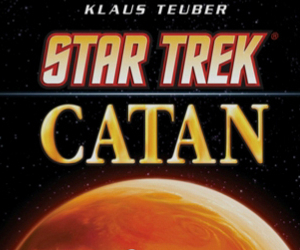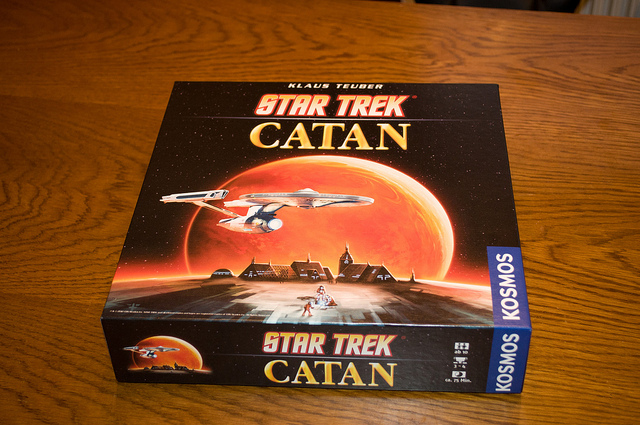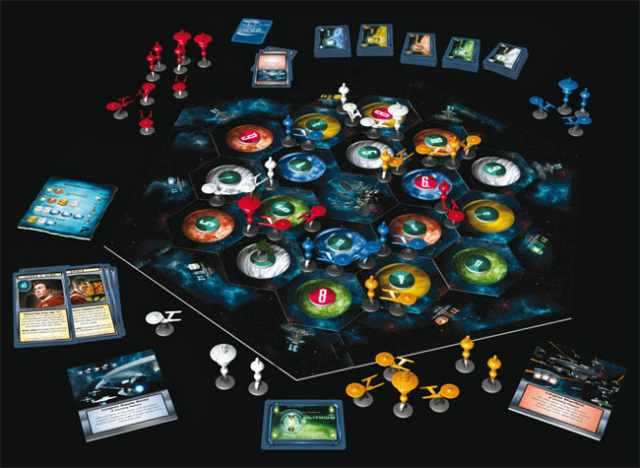Star Trek: Catan Review
 Game: Star Trek: Catan
Game: Star Trek: Catan
Designer: Klaus Teuber
Publisher: Mayfair Games
I have a confession to make. Despite having moved in the more nerdy circles for the majority of my life, I have never sat down and played a game of The Settlers of Catan. However, thanks to the kind folks at Esdevium Games, this was all about to change.
Attempting to rustle up a group to play it with by appealing to people from said circles via Facebook didn’t prove too difficult, perhaps not surprisingly, with one response reading “YES YES YES OH GOD YES”, and once we finally managed to do so, which turned out to be at midnight one evening as we had to trek from one house to another in the dark after our fourth player ditched us to go and watch Dollhouse elsewhere, the fun began.

For those not familiar with it, or indeed board games in general, The Settlers of Catan was first published in Germany in 1995 by Klaus Teuber, dental technician and board games designer (he only retired from the former to become the latter full time in 1999, which probably tells you something about the industry). Players must build settlements, cities and roads in order to settle the eponymous island, which is comprised of a series of randomly laid out hexagonal tiles that each produce various different kinds of resources, the amount dictated by dice rolls or, in the case of some editions, decks of numbered cards.
This edition of Catan, as is to be expected, gives the game not only a Star Trek-flavoured re-skin but also a few tweaked – and, of course, thematically appropriate – mechanics. Each player starts the game with two outposts, placed at the intersections between the planet hexes in order to obtain their resources, and two starships, these replace settlements and roads respectively. Outposts can be upgraded to starbases (cities), which double both their resource yield and the number of victory points they are worth and, as their name suggests, having the most victory points in a Catan game is generally advantageous. Development cards can be purchased in order to accrue additional points or else give access to special abilities, for example a Starfleet intervention, handy if you’re in somewhat of a bind thanks to the Klingon menace.
The Klingons take the place of the robber in regular Catan, with the battle cruiser stopping resource production on the planet on which it is placed every time a seven is rolled, and stealing half the resources of players with eight or more in their possession. Meanwhile, the addition of the support cards, a new element in this edition of the game, is a welcome one, with each featuring a famous Star Trek figure who, for those interested, are Kirk, Spock, McCoy, Sulu, Scott, Uhura, Chekov, Chapel, Rand and Sarek. They each offer a special ability, these ranging from forced trade (Uhura) to protection from the dreaded seven (Kirk, the jammy git). It was noted during our games by our more experienced player that the inclusion of these cards was a really great addition as they helped prevent players from getting quite so backed into a corner, or at least gave them a number of ways in which they could get out of it if they did end up in one.

But, perhaps most importantly of all, how was actually playing the game?
The board and pieces, once popped out and assembled, looked good and were of a high quality, with impressive art and graphic design by Franz and Imelda Vohwinkel respectively. Assembly and set up in preparation for a game didn’t take long at all, and the inclusion of both a quick reference rules sheet, though perhaps not as quick as some might be used to, and almanac, a more detailed explanation of the game’s rules with examples, proved more than sufficient for newcomers, such as myself and some of the other players, to quickly pick up the rules.
In Star Trek: Catan, the resources you get to play with are dilithium, tritanium, food, oxygen and water, the production of each of these dictated by the colour of the planet and the number on the randomly assigned counters placed on top of them. The games we played saw some pretty unfortunate resource distribution across the board, with the food and tritanium hexes inexplicably managing to clump together and resulting in certain players having a monopoly, especially where the latter was concerned. Trading is allowed and indeed encouraged in Catan, and there are even special non-player trading posts at the edges of the board that can be claimed, but this doesn’t stop some pretty shady – and unfair – deals being made. Three oxygen for one tritanium? Extortion!
So was it fun? Everyone certainly seemed to enjoy themselves, aside from during a couple of brief moments of tension when the late hour combined with simultaneous sugar crashes resulted in some minor disputes, but this is to be expected during any extended period of time spent board gaming, and all parties involved agreed that subsequent games should definitely be played. We even got through multiple games with surprisingly few inappropriate Star Trek jokes; though I’ll certainly never look at the Vulcan salute in the same way again.

VERDICT: Catan is a classic board game regardless of edition, and even if you’re not a great Star Trek – or even board game – fan, you’re still likely to enjoy spending an hour or two on a game. While the rules may seem a little complicated to some at an initial glance, even we were momentarily intimidated by the presence of the rules almanac, they’re really not; if you can handle Monopoly, you can certainly get to grips with Star Trek: Catan. Just be careful who you play with, board games are serious business.
[nggallery id=1127]




